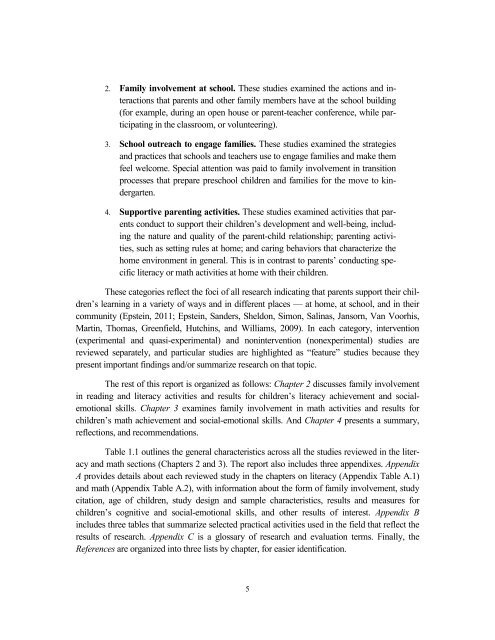u3QtN
u3QtN
u3QtN
You also want an ePaper? Increase the reach of your titles
YUMPU automatically turns print PDFs into web optimized ePapers that Google loves.
2. Family involvement at school. These studies examined the actions and interactions<br />
that parents and other family members have at the school building<br />
(for example, during an open house or parent-teacher conference, while participating<br />
in the classroom, or volunteering).<br />
3. School outreach to engage families. These studies examined the strategies<br />
and practices that schools and teachers use to engage families and make them<br />
feel welcome. Special attention was paid to family involvement in transition<br />
processes that prepare preschool children and families for the move to kindergarten.<br />
4. Supportive parenting activities. These studies examined activities that parents<br />
conduct to support their children’s development and well-being, including<br />
the nature and quality of the parent-child relationship; parenting activities,<br />
such as setting rules at home; and caring behaviors that characterize the<br />
home environment in general. This is in contrast to parents’ conducting specific<br />
literacy or math activities at home with their children.<br />
These categories reflect the foci of all research indicating that parents support their children’s<br />
learning in a variety of ways and in different places — at home, at school, and in their<br />
community (Epstein, 2011; Epstein, Sanders, Sheldon, Simon, Salinas, Jansorn, Van Voorhis,<br />
Martin, Thomas, Greenfield, Hutchins, and Williams, 2009). In each category, intervention<br />
(experimental and quasi-experimental) and nonintervention (nonexperimental) studies are<br />
reviewed separately, and particular studies are highlighted as “feature” studies because they<br />
present important findings and/or summarize research on that topic.<br />
The rest of this report is organized as follows: Chapter 2 discusses family involvement<br />
in reading and literacy activities and results for children’s literacy achievement and socialemotional<br />
skills. Chapter 3 examines family involvement in math activities and results for<br />
children’s math achievement and social-emotional skills. And Chapter 4 presents a summary,<br />
reflections, and recommendations.<br />
Table 1.1 outlines the general characteristics across all the studies reviewed in the literacy<br />
and math sections (Chapters 2 and 3). The report also includes three appendixes. Appendix<br />
A provides details about each reviewed study in the chapters on literacy (Appendix Table A.1)<br />
and math (Appendix Table A.2), with information about the form of family involvement, study<br />
citation, age of children, study design and sample characteristics, results and measures for<br />
children’s cognitive and social-emotional skills, and other results of interest. Appendix B<br />
includes three tables that summarize selected practical activities used in the field that reflect the<br />
results of research. Appendix C is a glossary of research and evaluation terms. Finally, the<br />
References are organized into three lists by chapter, for easier identification.<br />
5


